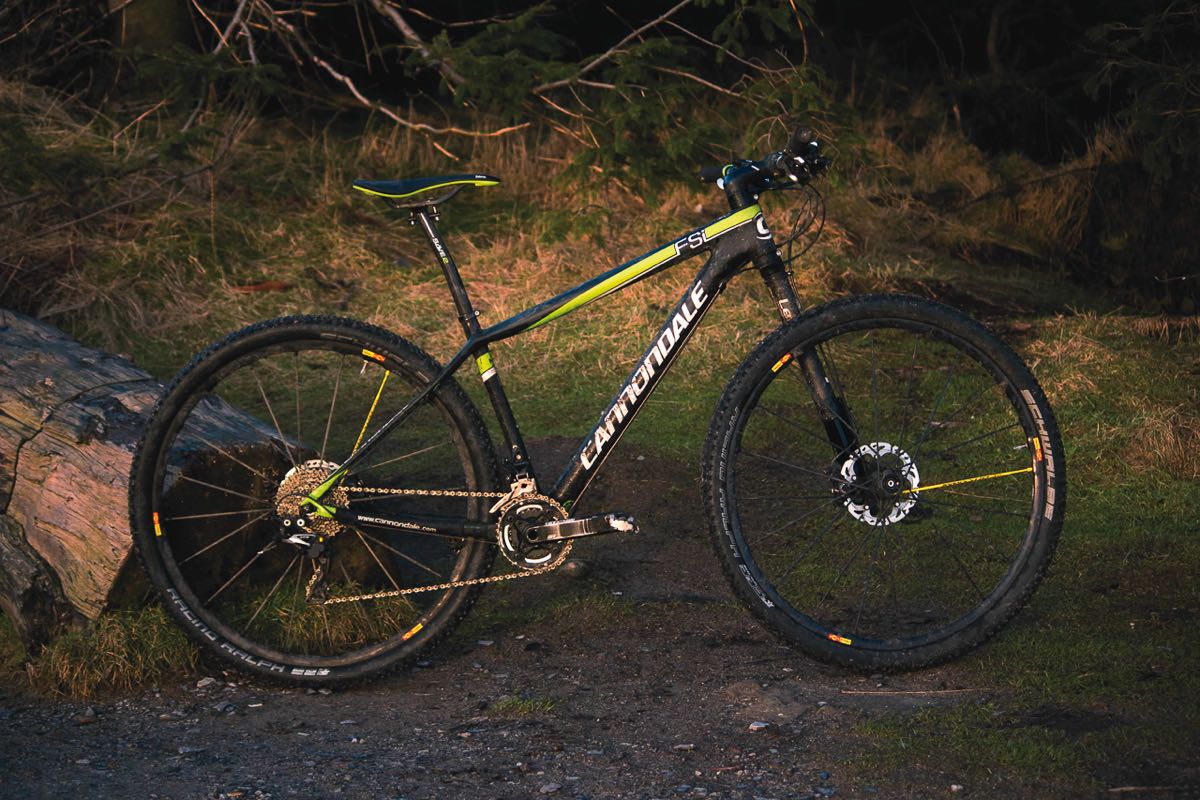There are many solid factors that a cross-country racer needs (or thinks they need) from their bike.
http://vimeo.com/119454513
It needs to be lightweight, it needs to be stiff and efficient, preferably with an instant lockout for climbs and sprints, and it needs to nippy enough in the trees to be able to power away from your rivals and crush their spirits. Cannondale’s hardtails (and Scalpel model) have long been favourites of the minimal body fat brigade and, so when Cannondale set about a redesign of the range, it knew that it needed something special to attract the race-curious, that wouldn’t alienate the existing fans.
One of the holy grails that race bike designers seek is the shortest chainstay length possible. With 29in wheels now being derigueur for cross-country racing, getting that back end tucked in is harder than with smaller wheels, due mainly to the front derailleur clashing with the rear tyre. While it’s possible to eliminate that front mech and run 1×10 or 1×11, Cannondale didn’t want to limit its options and force racers to accept a more limited range of gears.
So, it looked at alternative ways of getting that rear end short and decided to move the whole transmission 6mm outboard, both at the double chainset and at the rear hub, without affecting the Q-factor at the cranks. The rear hub sits 6mm towards the drive side; though, by running an undished rear wheel through an asymmetric back end, the rear rim sits perfectly in line with the front rim. An undished wheel is also a stronger structure.
Although this modification means that the bike takes non-stock rear wheels, the components it uses are freely available (and you could fit a regular dished rear wheel in there at a pinch, say in a race situation). Besides, it’s not like the Lefty front hub is that standard anyway… All this achieves a 429mm chainstay length (cue angels singing).
Moving away from the clever transmission for a second, the bike frame is a marvel in contemporary carbon frame manufacture, with big tubes where stiffness is needed and skinny, sculptured seatstays where more compliance is favoured. The frame still carries a lifetime warranty and a rider weight limit of 136kg.
Up front, a new Lefty 2.0 gives 100mm of travel with precise steering, while its new upside-down design offers better bushing wear and a measurable sag-indicator. Other components are fitting for a top-level race machine (although there are two more spec levels above this one available), such as the Shimano XT/XTR transmission and XT race brakes. Mavic supplies the Cannondale-specific new XLR wheels, shod with Schwalbe Racing Ralph 2.1in tyres.
Trail notes
If you’ve not ridden a top-level race bike for a while, the FSi will shock you. Not just with its weight – a sylph-like 21.2lb – but with how normal it all feels. There’s not a hint of flex or sketchiness in riding the Cannondale as fast as you dare. Pedal harder and the bike shoots forward. Any concerns about the shifted transmission or the ‘missing’ fork leg are instantly forgotten as you just get on with riding around at an astonishing speed.
The SAVE 2 carbon seatpost does a good job of flexing under the rider to offer a tiny bit of comfort, which is more than the fork will do when locked out. Using a RockShox Reverb-style push-button lockout, the fork instantly transitions from giving 100mm of smooth travel, to completely rigid and offering absolutely none. (Our lockout lever arrived in dire need of bleeding as it would randomly lock and unlock, but it’s a five-minute job to fix and ours has been fine since.)
Other components have been perfect for the duration – the 2×10 gear selection is great and it’s great to see a race bike with proper, stopping brakes fitted. Too often cross-country racers get the tiny rotors and ineffective brakes, but the XTs on the FSi inspire the confidence to ride faster, knowing you can stop quicker.
Cannondale is keen to point out that the FSi isn’t just a race bike, and there’s some truth in that. Its 69.5° head angle and 100mm of fork travel puts it into the ‘nippy trail hardtail’ category, and even the 700mm bars don’t look too out of place in the trail centre car park. However, it’s on the racecourse, the training loop and flat-out, twisty woodland mates’ races that the FSi is going to really earn its keep.
Overall
For all of Cannondale’s trail-bike claims, even if you put some chunky, wider tyres on it the FSi will still be a race bike. This is a bike that can’t not race anything and anyone it sees. There are people out there like that, and this is their bike. If you can’t resist reeling riders in, blowing past them at the top of the climb and holding them at bay on the descent, then you need to try this bike.
A wish-list of components, an instantly locking out, precise fork and a frame that kicks the pace up a notch at the slightest provocation; it’s all you need to crush rivals, on the race course, or off it.
Frame // Cannondale FSi carbon
Shock // n/a
Fork // Cannondale Lefty 2.0, 55mm offset, PBR Remote
Hubs // Mavic SLR
Rims // Mavic SLR
Tyres // Schwalbe Racing Ralph
Chainset // Cannondale Si, FSA rings
Front Mech // SRAM X0
Rear Mech // Shimano XTR Shadow Plus
Shifters // Shimano XT
Brakes // Shimano XT Trail (Race listed on spec).
Stem // Cannondale Si
Bars // Cannondale carbon 700mm
Grips // Cannondale foam lock-on
Seatpost // Cannondale SAVE 2
Saddle // Fabric, carbon rails
Size Tested // Medium
Sizes available // S, M, L, XL
Weight // 21.18lbs (without pedals)



















